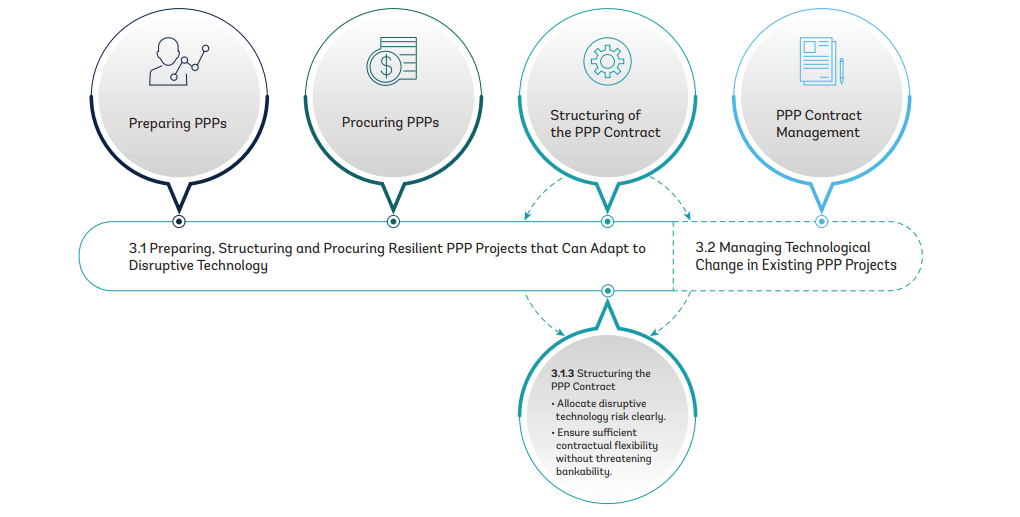Structuring the PPP Contract

Photo Credit: Image by Pixabay
On this page: Long-term, complex PPP projects always have to deal with unpredicted changes and PPP contracts need flexibility that allows unexpected circumstances to be accommodated within the contract, thus reducing the chance of disputes, lengthy renegotiations, and early termination.
Long-term, complex PPP projects always have to deal with unpredicted changes. Traffic volumes may turn out to be lower or higher than the predicted demand for a tolled highway project; efficiency-enhancing technology may become available for a water treatment plant; network assets may last more or less time than assumed. PPP contracts are therefore necessarily incomplete; they need flexibility to be built in - flexibility that allows unexpected circumstances to be accommodated within the contract, thus reducing the chance of disputes, lengthy renegotiations, and early termination. Such adjustment mechanisms create processes and boundaries for change. The fast pace of recent technological progress and its dynamic and global impact make PPP contracts, however, more vulnerable to unpredictable change than ever before.1 In this changing environment, the ability to adapt quickly to disruptive technology can make the difference between the success of a project and its failure. More contractual flexibility can be ensured prior to signing through proper contract drafting that takes technological disruption, and the possibility that economic conditions change after the PPP contract has been signed, into account. This may require a customization of the risk allocation to the distinctive characteristics of a project and drafting of bespoke PPP contractual provisions. These have to provide enough flexibility to permit a swift response to technological progress without threatening the bankability and affordability of projects. To achieve this goal, a clear allocation of disruptive technology risks is important - keeping in mind that the private partner will likely charge a risk premium if it has to assume disruptive technology risks that cannot be properly priced or assessed. Ultimately, a balanced and reasonable risk allocation requires that all stakeholders in a PPP project have the comfort that situations that are beyond their immediate control and that affect contractual performance will be dealt with in a way that allows them to arrive at a mutually acceptable solution.2 This section outlines basic considerations related to risk allocation in the face of rapid technological progress. The applicability and scope of typical adjustment mechanisms together with guidance for future PPP contracts is discussed in more detail in Managing Technological Change in Existing PPP Projects. The first step toward structuring a PPP is often to put together a list of all the risks associated with the project. After the project risks have been identified and analyzed, they need to be allocated between the contracting authority and the private partner and translated into legal obligations in the draft PPP contract. The underlying principle is that the risks associated with carrying out a PPP project are allocated to the party best able to control or to manage the consequences of the risk. Considerations for a balanced allocation of risks related to disruptive innovation: Demand Risk: PPP Payment Models There are different PPP payment models that vary depending on the allocation of the demand risk. The potential consequences of changes in demand therefore depend on the PPP payment model. The basic PPP payment models are: User-pays model (user pay contracts): In this payment model, the private partner generates revenue by charging end-user fees, tariffs or tolls. Under this approach, the private partner and its lenders bear the demand risk, i.e., lower number of users or usage volume than anticipated. A lower demand than what was forecasted thus reduces the revenue of the private partner. Typical examples are PPP road projects where tolls are collected directly by the private partner. Government-pays model (availability-based contracts): In this model, the private partner receives regular payments from the contracting authority if the infrastructure asset or its services are available at a contractually defined quality regardless of the level of use. In these cases, the contracting authority retains the demand risk, and the total revenue of the private partner does not change if demand decreases. The government revenue can be higher or lower than the payments made to the private partner—which can have severe long-term fiscal and budgetary implications. Government-pays models are common for PPP projects that do not have a steady revenue stream, or projects where the government prefers to take the demand risk, e.g., for policy reasons. Typical examples are PPPs in social sectors, such as schools or prisons, or toll road concessions where the government assumes all traffic risk. Minimum revenue guarantees (take-or-pay clauses): Minimum revenue guarantees are user paid, but if there is a shortfall below a certain threshold, the contracting authority will make up such a shortfall. Thus demand risk is passed largely to the contracting authority. Minimum revenue guarantees are often found in urban transport projects, for example. A similar concept exists in energy sector power purchase agreements, which often contain a take or pay clause that obliges the offtaker or utility to take a minimum amount of electricity or pay for any shortfall. This clause provides the project owner with a guaranteed offtake, but it can become burdensome for public utilities if it ends up paying for more electricity than it needs. This issue is exacerbated in the case of technological change; for example, when governments are being pressured to meet climate goals and renewable energy targets but are currently still under contract for paying for a certain amount of electricity generated by coal power, limiting their ability to pivot to building new renewable energy plants. In some instances, utilities simply cannot afford the capacity payments under PPAs that they have signed, and are thus subjecting the project owners to curtailment of electricity. Future contracts should consider building in flexibility for take-or-pay clauses in specific circumstances. Often, there are moratoriums on such payments in the case of force majeure. Such contracts can possibly also consider allowing the project owner to find other ways of offloading their electricity (i.e., liberalizing the market) so that the burden of meeting demand does not reside with the utility. It is impossible to assess all possibilities and allocate all potential risks correctly over a long period of time in large projects that take place in regulated sectors, diverse political settings, and at times of increasingly complex and interconnected technology. Therefore PPP contracts need to have some flexibility built in that allows the parties to incorporate new technologies, find solutions to share high upfront costs, and gain sharing mechanisms, all while managing unforeseen circumstances within the contract to avoid disputes, renegotiation, and termination as much as possible. Flexibility that allows projects to keep pace with innovation can be found to some extent in basic provisions that take a degree of technological change into account. These are the first provisions that should be strengthened in future contracts in order to ensure sufficient flexibility in dealing with technological change. Moreover, PPP contracts incorporate a set of typical provisions to deal with unexpected change and allocate associated risks to the parties. These provisions need to be reviewed in light of rapid technological change. Ultimately, however, a long-term PPP contract will be limited in how much flexibility can be introduced without threatening its bankability. PPP projects are by nature dependent on a set financial model at the outset to raise financing for the upfront construction costs. Once that financing is committed, it is very difficult to adjust any variables or assumptions in the model, and attempts to do so almost inevitably result in renegotiation or disputes.
Footnote 1: Disruptive technologies and their impacts on infrastructure, including risks and opportunities for infrastructure PPPs, are described in more detail in Disruptive Technology, Infrastructure and PPPs Footnote 2: For further details on risk allocation, see the World Bank Group’s 2019 Guidance on PPP Contractual Provisions Addressing risks and opportunities related to technological innovation.

Risk allocation
Enhancing flexibility
The Disruption and PPPs section is based on the Report "PPP Contracts in An Age of Disruption" and will be reviewed at regular intervals.
For feedback on the content of this section of the website or suggestions for links or materials that could be included, please contact the PPPLRC at ppp@worldbank.org.
Updated: July 16, 2024
TABLE OF CONTENTS
Executive Summary for Disruption and PPPs
Disruptive Technology, Infrastructure and PPPs